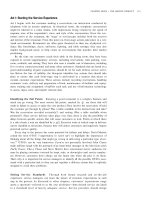Consumer behavior and marketing strategy 12e hawkins motherbaugh chapter 01
Bạn đang xem bản rút gọn của tài liệu. Xem và tải ngay bản đầy đủ của tài liệu tại đây (1.6 MB, 25 trang )
CHAPTER
01
Consumer Behavior and
Marketing Strategy
McGraw-Hill/Irwin
Copyright © 2013 by The McGraw-Hill Companies, Inc. All rights reserved.
PART I: INTRODUCTION
1-2
Learning Objectives
Define consumer behavior
L01
L01
Summarize the applications of consumer behavior
L02
L02
Explain how consumer behavior can be used to develop marketing strategy
L03
L03
Explain the components that constitute a conceptual model of consumer behavior
L04
L04
Discuss issues involving consumption meanings and firm attempts to influence them
L05
L05
1-3
Consumer Behavior In The News…
Target Marketing. Just Your Average Triathlete?
Can you predict the demographics of the average triathlete?
Income:
Age:
Gender:
Marital Status:
Source: N. Zmuda, “Forget Golf,” Advertising Age, October 10, 2011, p. 8.
1-4
Consumer Behavior In The News…
Target Marketing. Just Your AverageTriathlete?
Demographics of the average triathlete?
Income: $126,000
Age: 38 Years Old
Gender: 60% Male
Marital Status: 63% Married
Key Target Market: Higher income corporate executives who spend heavily on the
sport.
Source: N. Zmuda, “Forget Golf,” Advertising Age, October 10, 2011, p. 8.
1-5
Consumer Behavior and Marketing Strategy
Consumer behavior is the study of individuals, groups,
or organizations and the processes they use to select,
secure, use, and dispose of products, services,
experiences, or ideas to satisfy needs and the impacts
that these processes have on the consumer and society.
1-6
Applications in Consumer Behavior
1.
Marketing Strategy
2.
Regulatory Policy
3.
Social Marketing
4.
Informed Individuals
1-7
Applications in Consumer Behavior
United Way Campaign Provides an Example
of Social Marketing
Courtesy United Way of Metropolitan Chicago
1-8
Marketing Strategy and Consumer Behavior
1-9
Market Analysis Components
1.
The Consumers
2.
The Company
3.
The Competitors
4.
The Conditions
1-10
Market Segmentation
Market segmentation is a portion of a
larger market whose needs differ from the
larger market.
1-11
Market Segmentation
Market Segmentation Involves Four Steps:
1.
Identifying Product-Related Need Sets
2.
Grouping Customers with Similar Need Sets
3.
Describing Each Group
4.
Selecting an Attractive Segment(s) to Serve
1-12
Market Segmentation
1-13
Marketing Strategy
Marketing Strategy is the answer to the question: How will we provide superior customer
value to our target market?
This requires the formulation of a consistent marketing mix, which includes the
1.
Product
2.
Communications
3.
Price
4.
Distribution, and
5.
Services
1-14
Video Application
The following Video Clip shows how digital signage (the
communications element) keeps the marketing message fresh!
1-15
1-16
Consumer Decisions
The consumer decision process intervenes between the marketing strategy, as
implemented in the marketing mix, and the outcomes.
The firm can succeed only if consumers see a need that its product can solve, become
aware of the product and its capabilities, decide that it is the best available solution, proceed
to buy it, and become satisfied with the result of the purchase.
1-17
Outcomes
1.
Firm Outcomes
2.
Individual Outcomes
3.
Society Outcomes
1-18
Outcomes
Creating Satisfied Customers
Pella Windows on Creating Satisfied Customers through Quality
YouTube Spotlight
1-19
The Nature of Consumer Behavior
Overall Conceptual Model of Consumer Behavior
1-20
The Nature of Consumer Behavior
External Influences
•
Culture
•
Demographics and social stratification
•
Ethnic, religious, and regional subcultures
•
Families and households
•
Groups
1-21
The Nature of Consumer Behavior
Internal Influences
•
Perception
•
Learning
•
Memory
•
Motives
•
Personality
•
Emotions
•
Attitudes
1-22
The Nature of Consumer Behavior
Self-Concept and Lifestyle
Self-concept is the totality of an individual’s thoughts
and feelings about oneself.
Lifestyle is how one lives, including the products one
buys, how one uses them, what one thinks about them,
and how one feels about them.
1-23
The Nature of Consumer Behavior
Situations and Consumer Decisions
Consumer decisions result from perceived
problems and opportunities.
Consumer problems arise in specific
situations and the nature of the situation
influences the resulting consumer behavior.
Using Outdoor Media to Trigger Problem Recognition
1-24
The Meaning of Consumption
Consumption has meaning beyond satisfaction of minimum or basic consumer
needs
Symbolic needs
Status
Identity
Group acceptance
1-25









